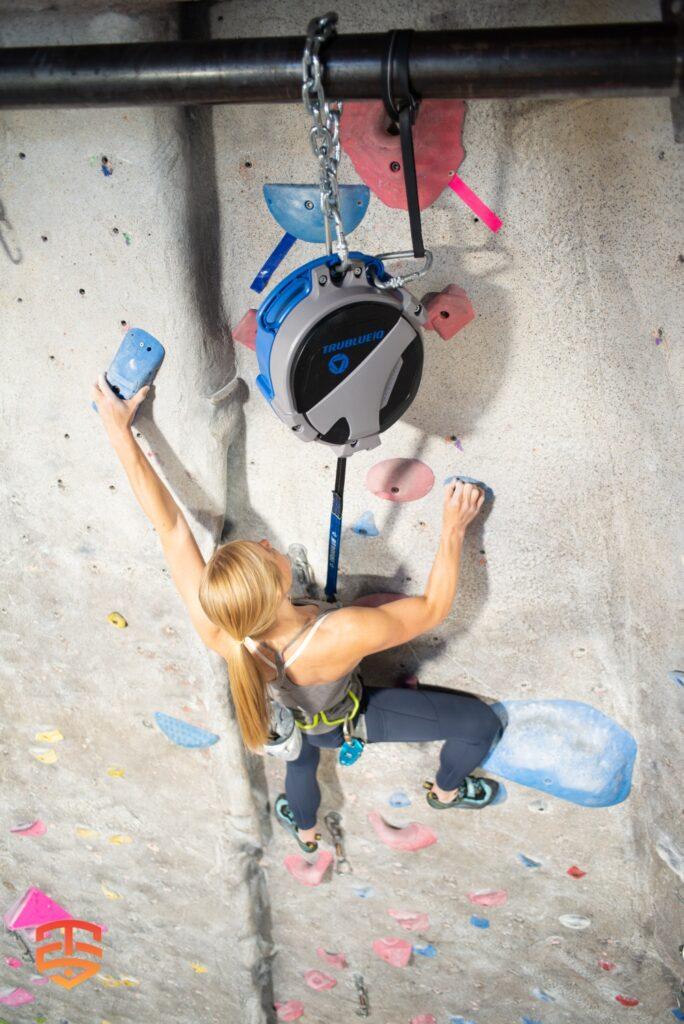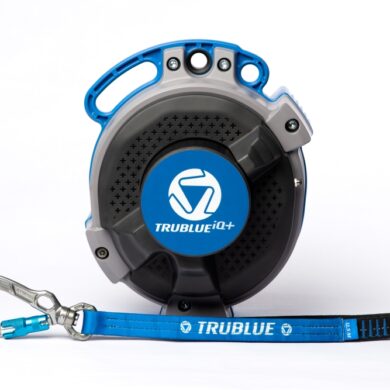
You may have seen them in climbing gyms, heard about them, or even used them – but you may not fully understand what is happening inside these belay systems. In this blog post, we breakdown and dissect the inner workings of an auto belay. Discover the secret to safe climbing with a comprehensive guide to the inner workings of belay systems and the convenience of Auto Belays. Learn what auto belays are and how they eliminate the need for a human belayer. Get a deeper understanding of this essential climbing equipment and find out how it helps novice climbers focus on their techniques and experience the thrill of climbing.
Nothing beats practicing your climbing sport in a safe environment! The thrill of a new route that is higher or faster than your previous climb comes first and foremost. Amazing, as well as the adrenaline rush! However, it is automatically protected against the dangers of one of our planet’s most underappreciated phenomena: gravity. After all, you can’t feel it, hear it, smell it, or see it, but it’s always present.
An Auto Belay Device is a type of automatic belay device that prevents slack in the climbing line as the climber ascends. If the climber falls or reaches the top, the Auto Belay immediately arrests the fall and lowers the climber safely and automatically to the ground. Auto Belays allow anyone to climb whenever they want, even if they don’t have a belay partner. With Auto Belays, novice climbers can concentrate on learning climbing techniques and enjoying their sport before having to master belay techniques.
What exactly is an climbing auto belay?
An auto belay is a climbing belay system that operates automatically via electromechanical or mechanical means. It eliminates the need for a human belayer by automatically retracting the climbing rope and taking up slack as you climb. The auto belay braking system ensures a smooth descent back to the ground once a climber has reached the top of the wall. If you fall, the auto belay safely slows your descent and returns you to the ground.
Before beginning to climb, the climber attaches himself to the device’s line. The rope (lifeline) automatically rolls into the device while climbing. After reaching the summit, the climber automatically descends at approximately 1 m/s, safely and comfortably, whenever she or he desires or in the event of a fall.
The following are the functions of an auto belay system: Eliminates the need for a human belayer; retracts the rope during ascent; controls descent; and protects against falls.
Advantages of Using an Auto Belay for Climbing
Auto belays are devices that are commonly used in climbing gyms to provide climbers with a safe and controlled descent without the use of a human belayer. Because of the numerous benefits they provide to climbers and climbing gyms, these innovative devices have grown in popularity over the years. Here are a few of the primary advantages of using an auto belay in climbing:
- Increased Safety: Auto belays use advanced technology to ensure that climbers descend safely. They are outfitted with sensors that detect a climber’s weight and provide a controlled descent in the absence of a human belayer. This reduces the possibility of human error, making auto belays a safer option for climbers of all skill levels.
- Enhanced Efficiency: Auto belays enable climbers to ascend and descend independently, eliminating the need to wait for a belayer. This not only saves time, but also expands the capacity of a climbing gym by allowing multiple climbers to use the same auto belay at the same time.
- Increased Convenience: Auto belays are simple to use and require little setup time. They are also open 24 hours a day, seven days a week, making them a convenient option for climbers who want to climb outside of regular operating hours.
- Lower Labor Costs: Because auto belays eliminate the need for a human belayer, they can significantly reduce labor costs for climbing gyms. This enables gyms to offer their customers more climbing routes and a better climbing experience without incurring additional labor costs.
- Improved Climbing Experience: Auto belays provide a smooth and controlled descent, allowing climbers to concentrate on their climb rather than the descent. This makes climbing more enjoyable and relaxed, especially for beginners who may be intimidated by the prospect of using a human belayer.
Finally, auto belays provide numerous advantages to climbing gyms and their customers. Auto belays have become a popular choice for climbers of all levels because they provide a safer, more efficient, and convenient climbing experience, and they are an essential component of any modern climbing gym.

What kinds of Climbing Auto Belay exist?
The hydraulic auto belay system is the most common type of auto belay system and can be found in mobile climbing towers at street fairs and carnivals. A hydraulic cylinder assembly and a cable redirected by pulleys and attached to the climber are used in this system. When the climber falls, the force is transferred to the hydraulic piston assembly, and the oil in the cylinder compresses through a small gap, slowing the climber’s descent. The strong upward pull of the hydraulic auto belays, on the other hand, may make it less suitable for experienced climbers.
Magnetic braking auto belays, on the other hand, use high-power magnets and conductive rotors to control a climber’s descent. A retraction spring absorbs the webbing during a climb. When a climber falls, the webbing starts spinning and generates tiny electric currents through the drum, causing an eddy current braking phenomenon that slows the fall to its maximum velocity.
To control a climber’s descent, friction braking auto belays use a retraction spring and a drum brake similar to a car’s parking brake. The brake uses friction drag to oppose rotation and slows webbing release. However, the device’s high thermal energy can cause brake fade, resulting in faster descent speeds.
Hydraulic Automatic Belays
The hydraulic auto belay system is the most traditional type of auto belay system. These are frequently seen in mobile climbing towers at street fairs and carnivals. A hydraulic cylinder assembly is fixed behind the climbing wall and connected to a cable in this system. Pulleys direct the cable up and over to the other side of the wall, where it descends and clips to the climber, transmitting any fall force to the hydraulic piston assembly. The hydraulic cylinders employ an air-over-oil mechanism to generate positive pressure in the assembly, which keeps the cable taut as the climber ascends.
The cylinders are filled with a mixture of air and oil. Compressing oil is impossible. When a climber falls, the rope pulls on the chambers, compressing the oil through a small gap. The chamber’s small amount of pressurized air allows for some movement, but it is very slow. The climber’s rope is slowed by the slow movement in the chambers and safely lowers them to the ground. The hydraulic cylinder’s pressure is also responsible for pulling up the slack during ascension. This, however, provides an additional ‘assistance’ to a climber. This is beneficial for young children climbing but not ideal for experienced climbers.
If the climber falls at any point, the force of the fall creates tension on the hydraulic cylinders, forcing hydraulic oil back out through a small fluid flow restriction valve. Because oil is an incompressible fluid, the climber’s descent rate is controlled by the act of attempting to compress the fluid while only providing a small outflow valve. The relationship between pressure, force, and area is exploited in hydraulics. There are two hydraulic cylinder assemblies in the system.
The strong upward pull on hydraulic auto belays can be useful for children just starting out, but experienced climbers prefer not to use it, and adults may need to pull their children back down to the ground because the upward pull is so strong. Hydraulic auto belays used in indoor rock climbing gyms are not portable, and drawbacks include costly cable replacement, high maintenance, the possibility of messy fluid leaks, and difficulty of access.
Auto Magnetic Braking Belays
On roller coasters, trains, and elevators, you may have experienced the smooth, repeatable deceleration provided by magnetic braking. There are two key components in a magnetic auto belay: conductive rotors and high strength magnets. During the climb, a large power spring known as a retraction spring absorbs the webbing (this is the same mechanism that makes tape measures recoil). If a climber falls at any point along the webbing line, the webbing wrapped around the shaft spins the entire internal assembly, creating a centrifugal force inside the drum. This is where things start to get interesting.
A strong magnetic field is maintained at all times by several Neodymium magnets attached to the outer edge of the webbing spool drum. The webbing spool begins to spin when a climber falls onto the webbing line. Centrifugal force draws the rotor’s conductive arms into the magnetic field, causing tiny electric currents to flow inside the drum. These distinct circular currents (known as Eddy Currents) generate their own magnetic field, which opposes the release of the webbing spool. This eddy current braking phenomenon reduces a climber’s fall velocity to its maximum, resulting in a smooth, controlled descent. The best part? The magnetic brakes are always engaged and only engage further in proportion to the weight of the climber.
Magnetic braking functions similarly to roller coaster brakes. Instead of friction, an electromagnetic field is used to control and slow down speed. Eddy currents are to blame for everything. Simply put, if you dropped a magnet through a plastic tube, it would fall quickly. However, if you drop it through a copper tube, it falls very slowly. This is due to the creation of an electromagnetic field around the magnet.
A retraction spring is connected to the climbing rope. The magnets kick in and stop the flow when the rope suddenly spins due to a fall.
Auto Friction Braking Belays
Friction auto belays, like magnetic auto belays, hang from the top of the wall and use a retraction spring to take in webbing as the climber ascends. A friction auto belay, as opposed to a magnetic one, employs a drum brake, similar to a car’s parking brake. Various friction auto belay models have been developed, with either a length of cable or a length of webbing attached to the climber. Because the webbing would retract very slowly if the brake was always engaged, these devices typically use a clutch system to disengage the brake during ascent (retraction).
The centrifugal force in a spinning drum is used by both magnetic and friction auto belay devices, but in very different ways. The force causes brake shoes to move outward against a metal drum (shown above), creating frictional drag that opposes rotation. These brake pads perform mechanical work by slowing the release of the webbing and controlling the fall of a climber, while also releasing kinetic energy as heat and leaving small dust particles (think what happens when you use a pencil eraser, you get rubber particles and it is sometimes hot to touch).
The high thermal energy inside the device causes the braking mechanism to deteriorate (a phenomenon known as brake fade), resulting in increased descent speeds during heavy use. Because brake dust affects the braking mechanism and heat reduces the amount of friction, a friction brake will deteriorate as the number of cycles increases. Magnetic auto belays do not have contacting, sacrificial wear parts that degrade in proportion to the number of climbs, which is why they are more commonly used in high throughput facilities. Furthermore, if a foreign substance, such as water, gets inside a friction drum brake, it can alter the frictional properties and cause catastrophic failure of the brake mechanism.
The device attaches to the top of a wall with friction braking auto belays. They function similarly to car brakes. It’s essentially a drum with a number of plates, or “shoes,” as they’re known. These shoes press against the inner side of the drum, generating friction from the centrifugal force generated during descent and lowering the climber at a safe and controlled rate.

What type of Climbing Auto Belay system is best for you?
Any indoor wall operator wants an auto belay that is simple to install, use, and relocate. As a result, indoor hydraulics are becoming less common. Second, an auto belay system must be able to withstand hundreds of climbs per day in high throughput facilities. A magnetic braking auto belay can withstand cycle after cycle without deterioration in braking performance, whereas friction devices will inevitably heat up and require brake pad replacement. The magnetic technology works as consistently as your compass points north.
The TRUBLUE Auto Belay is the only auto belay that uses magnetic eddy current braking technology, which provides advantages in addition to dependability and cyclic endurance. The patented magnetic braking mechanism of Head Rush allows each device to adjust to each climber’s weight and provide a consistent descent experience for everyone. The greater the weight of the climber, the more conductive material enters the magnetic field, and the more braking is applied. As a result, the TRUBLUE auto belays are self-regulating, providing climbers of all weights with the same descent experience.
So, now that you understand the various types of auto belays and how they work, go out and teach your friends! Maybe the next time you’re running laps at the gym, you’ll feel better about climbing on auto belays.

Vertical Auto Belay systems
Grow your climbing community by providing more access to more routes for more climbers.
Auto Belay makes climbing simple and approachable, turning first-time users into return customers. TRUBLUE Auto Belays are engineered to minimize maintenance and are built to last. Our patented magnetic braking system, delivers the smoothest user experience, the highest level of reliability, and dramatically reduces device downtime.
Dive Deeper: Exploring Auto Belay Technology with Expert Insights
Auto belays are transforming the world of indoor climbing, offering convenience and safety for climbers of all levels. But how exactly do they work, and what are the key considerations for using them? To learn more about the intricacies of auto belay technology and gain valuable insights from experts in the field, check out our additional resources below…
- Comparison of Auto Belay’s: what’s new in the TRUBLUE iQ series
- Using Technology to Make Your Climbing Gym Accessible and Inclusive
- A Closer Look at the Auto Belay System
- Next Generation Auto Belay – TRUBLUE iQ
- Every modern climbing gym should have these 5 features
- Everything You Need to Know about Buying Auto Belays
- Increase Revenue and Customer Satisfaction at Family Entertainment Centers
- Catch-and-Hold: What is it and how does it work?
- Leading the Way in profitable and safe climbing
- Why Family Entertainment Centers Trust TRUBLUE Auto Belays
- Creating Value for Customers by Using an Auto Belay
- TRUBLUE iQ+ World’s first catch-and-hold auto belay
- Drive Revenue and Customer Satisfaction with Auto Belays
- 7 Ways Magnetic Braking Is Better Than Friction
- No Belayer Necessary: Understanding Auto belays
- Competitive Advantage of an Auto Belay
- ROI at Climbing Walls and Family Entertainment Centers
- Auto-Belay and hands-free climbing challenges
- Why using Auto Belays Boosts your Business
- The Science of Eddy Current Magnetic Braking
-
 TRUBLUE iQ+ | Catch & Hold Auto Belay€ 4.399,00 – € 4.759,00 Ex VAT
TRUBLUE iQ+ | Catch & Hold Auto Belay€ 4.399,00 – € 4.759,00 Ex VAT -
 TRUBLUE SPEED Auto Belay | 7,5 – 16 meter€ 2.799,00 – € 3.059,00 Ex VAT
TRUBLUE SPEED Auto Belay | 7,5 – 16 meter€ 2.799,00 – € 3.059,00 Ex VAT -
 TRUBLUE iQ Auto Belay | 4,5 – 20 meter€ 2.799,00 – € 3.159,00 Ex VAT
TRUBLUE iQ Auto Belay | 4,5 – 20 meter€ 2.799,00 – € 3.159,00 Ex VAT







